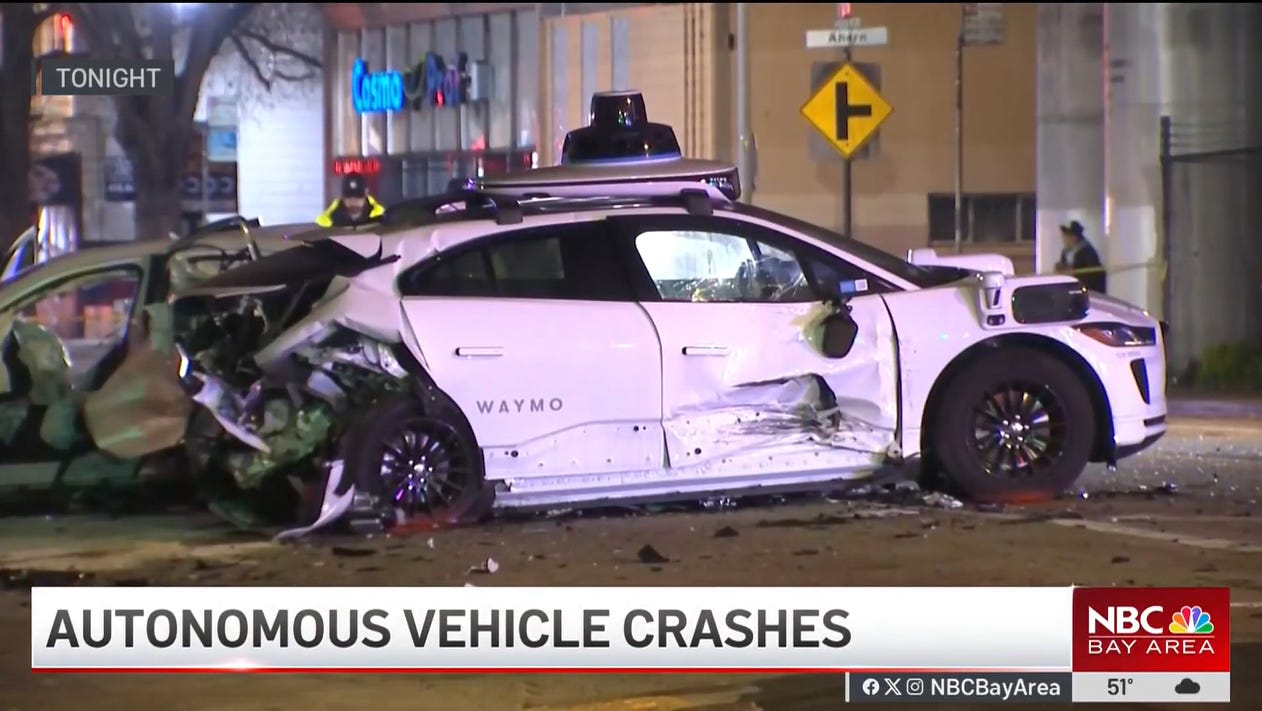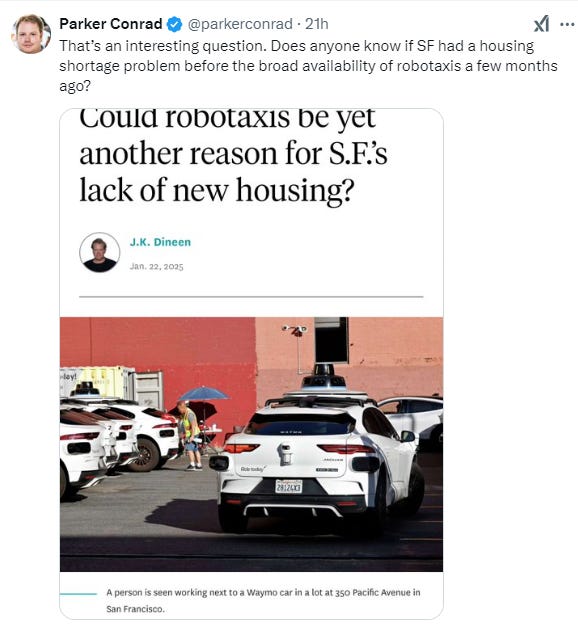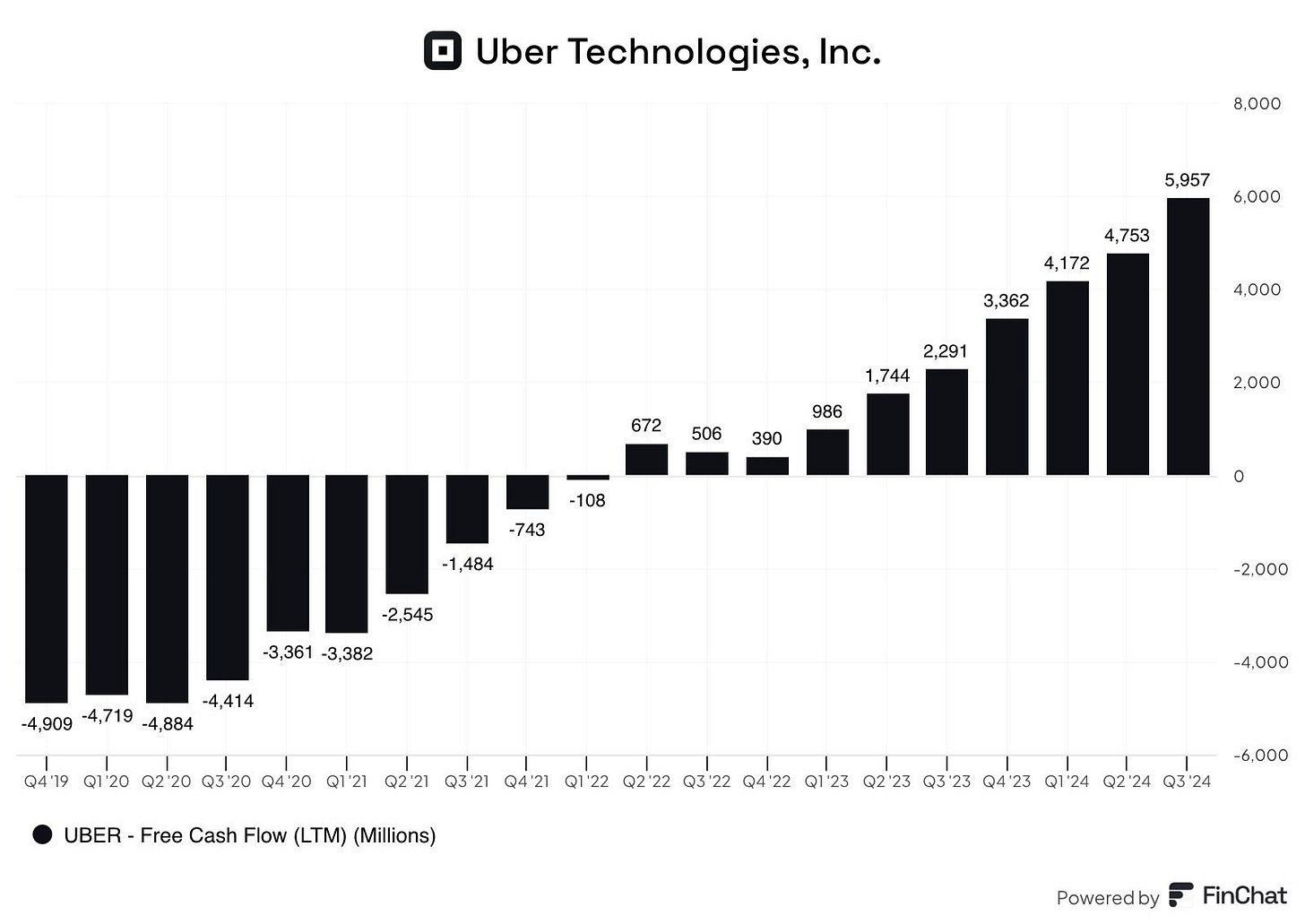Uber CEO Says Drivers are Safe From AVs…for Now
Waymo and multiple cars rammed into by a speeding car, could robotaxis be the reason for SF’s lack of housing?, Tesla Cybercab spotted with steering wheel raises questions.
Top Stories of the Week
Uber CEO's interview on CNBC's Squawk Box—he points out that while AV technology might be ready between now and the next two years, AV commercialization will likely take much longer (link). Dara hit the nail on the head here since we don’t know much about Waymo’s true cost structure other than they are expensive, and the company’s number one goal should be to reduce costs and improve utilization. There’s no better way to do that than on the Uber platform since Waymo can negotiate a favorable deal where they get priority requests (at airports, shorter ETAs, highest rated passengers, no deadhead trips, etc) and premium levels of service/pricing (ie UberBlack or UberComfort Electric). The density on Uber’s network is so high that Waymo can effectively cherry pick the best rides and leave the scraps for everyone else.
I also liked Andrew’s question about human drivers competing with robots and while I agree that there will be a hybrid fleet for quite some time, adding Waymos does increase supply, which means lower earnings for human drivers. Especially if the human drivers get left with the less favorable rides. This is a good thing for Uber, since they can increase their margins as long as demand stays steady, but it is bad for individual drivers. Fleet owners with Uber (ie the ones currently renting out to human drivers) can/are already negotiating better deals so they may be well positioned in this scenario.
Empty Waymo, Not at Fault, Involved in Fatal Multi-Car Crash That Claims the Life of One Person and a Dog in San Francisco (link). This incident, caused by a speeding vehicle crashing into a line of cars stopped at a red light, marks the first time in the U.S. that a fully autonomous vehicle, with no driver on board, has been involved in a fatal accident. I can only imagine how badly editors around the world wanted to write a headline that implied Waymo was at fault, but kudos to NBC news for accurately portraying what happened.
This Waymo was in the wrong place at the wrong time, but as the company scales, deaths are going to happen, and there may even be accidents where they’re at fault. I think this is one of the big reasons why Waymo hasn’t rolled out on freeways yet, since automobile deaths are more likely at higher speeds. And even when Waymo isn’t at fault, some headlines are going to imply blame for the clicks.
Cool Rides
One highlight from our recent trip to LA was taking a trip in a driverless vehicle with Waymo (link).
Taking a driverless car in San Francisco. I was skeptical, but these are actually SO cool! (link).
Dog in the front seat of a Waymo (link). Funny, but on a more serious note, pets—other than service animals—aren’t allowed in a Waymo. Just another issue that Waymo will have to figure out a solution for. Human drivers deal with this and especially service dog fraud on a weekly basis - it’s a tricky issue that Uber and Lyft have spent a lot of resources and time dealing with.
AVs and/or Humans behaving badly
Waymo vs. Muni - A Game of Inches (link). Pretty sure we saw something like this before 😭
Other Stuff
The article title (link, no paywall) feels a bit silly and a lot of pro-tech folks were making fun of the notion, but I think it raises an interesting question about the second order effects of AVs on real estate. I’ll let others argue about the policy side but if property owners are building out charging lots instead of new buildings, that will have a negative effect on the housing supply.
Most Uber drivers also can not afford to live in the higher socioeconomic areas where demand is. Take the 7 x 7 in San Francisco where most rides are, Uber drivers making $25-30 an hour, typically live down South, East Bay, North or even further out. Uber doesn’t pay for the trips in/out of the city, so you can think of the commute as unpaid time for drivers - similar to a lot of other workers who commute in/out of the city.
Waymo needs depots in the areas where rides occur though since they need to charge, clean and store their vehicles 2-3 times per day. And driving too far in/out of the city at the end of a shift, would also impact the vehicle’s range. So add another challenge and cost to Waymo’s bottom line.
From Goldman Sachs and Sensor Tower: Waymo monthly active users (MAU) are at 2% of $UBER US MAUs, 5% of $LYFT. Waymo has higher user churn, with significantly lower usage frequency when looking at the same markets, suggesting some use is more about experimentation and for the novelty-factor (h/t Next).
I have never seen a Waymo ride in SF cheaper than Uber or Lyft (link). Anecdotally, I'd say Waymo is consistently more expensive than Uber and Lyft, but it’s not hard to find a route where it's about the same or slightly cheaper, especially during surge, since Waymo limits their surge algorithms versus Uber that keeps it open to incentivize more drivers. But remember, Waymo is basically just making up prices at this point, whereas Uber is actually turning a profit. Not a bad thing but just take advantage of those Waymo rides in $75,000 Jaguar I-Paces while you can :)
New Drone Footage of the Waymo Factory in Arizona shows around 2000 cars (link). Pretty cool shot!
Hidden Waymo feature let researcher customize robotaxi’s display (link).
Coming to a city street near you? Coco, the food delivery robot (link).
Tesla Cybercab spotted with steering wheel raises questions (link).
Until next week.
-Harry
Never miss a Driverless Digest update! Follow us on Twitter/X and LinkedIn.





